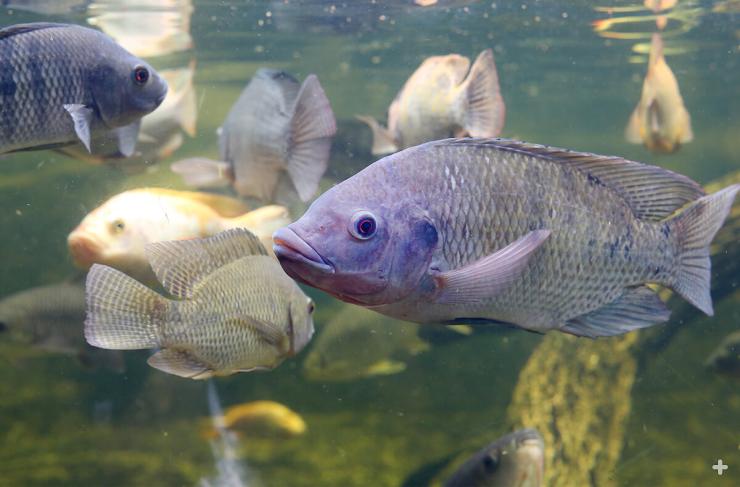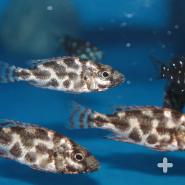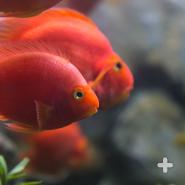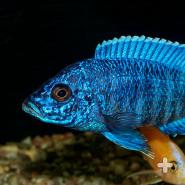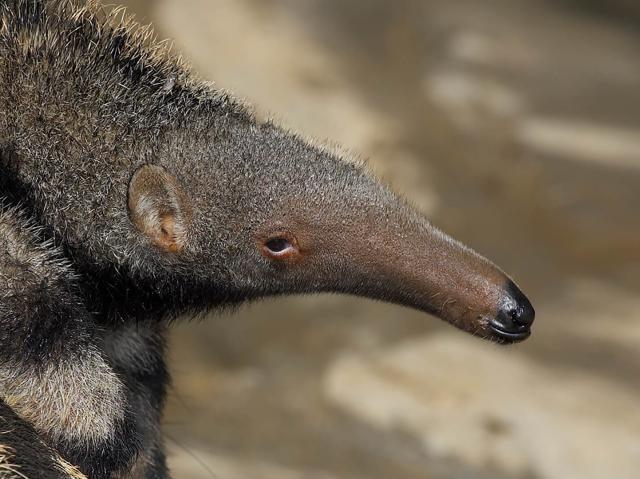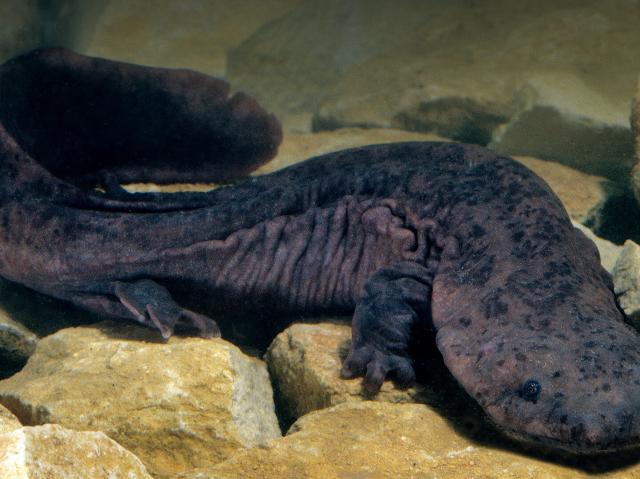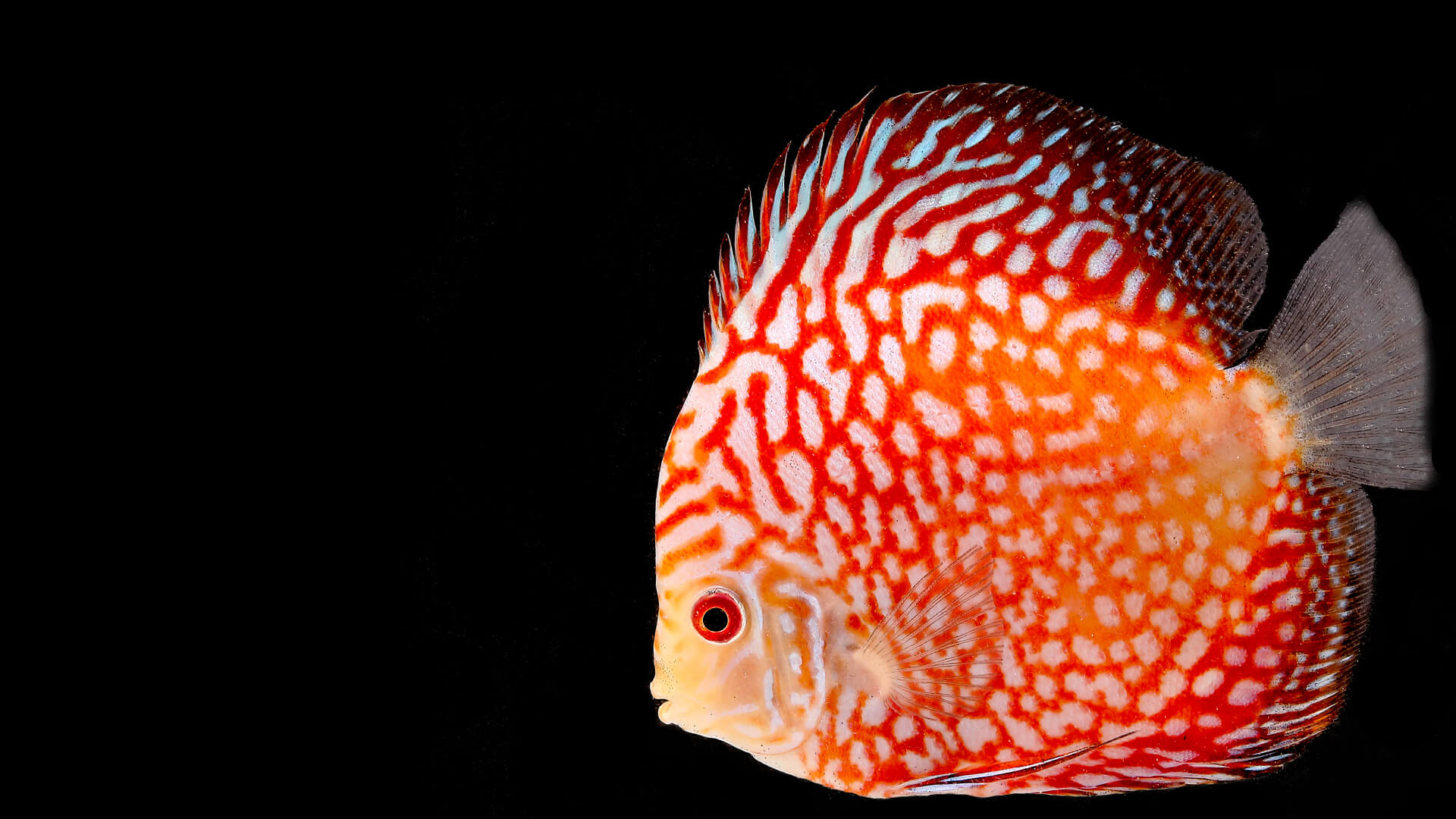
Cichlid

- Class: Actinopterygii
- Order: Perciformes
- Family: Cichlidae
- Genus and Species: Well over 1,000

ABOUT
Cichlid fish (pronounced “sick-lid”) are a large family of freshwater, bony fish. While the exact number of species is unknown, it’s thought that well over 1,000 exist in the Cichlidae family today. Of all the species of vertebrates, more than five percent are cichlids.
Vivid, vibrant, and varied, cichlids include angelfishes, Oscars, discus, green terror, yellow lab, firemouth, blood red parrot, humphead, and convict. A common member of the Cichlid family is the tilapia. Tilapia are part of the group of cichlids native to Africa or Asia, and are important as food fish in the tropics and, increasingly, in subtropical and even temperate climates.
The cichlidae family is just one of the 482 families of fishes. There are over 25,000 species of fishes all together, which incidentally is more than all the birds, mammals, reptiles and amphibians combined.
Being colorful, fairly easy to maintain, and interesting to observe makes cichlids popular with aquarium enthusiasts. Others are farmed as an important source of protein in many countries.
HABITAT AND DIET
Diversity. Cichlids have a remarkable degree of specialization. Each is different and exploits its environment in its own way. Different cichlid varieties do not often compete for food, as each species has distinct dietary needs.
Cichlids are found in almost every possible body of freshwater within their geographic range including rivers, lakes, swamps, and even ditches and puddles. They are not found at high elevations and generally require water warmer than about 68 degrees Fahrenheit (20 degrees Centigrade). Although typically a freshwater fish, one cichlid can be found in the Salton Sea of California, where salinity levels are higher than that of the ocean!
Fish without borders. Cichlids are found in the Americas, from southern Texas down to Argentina in South America. They are found throughout Africa and parts of the Middle East. There are cichlids on the island of Madagascar, on the island of Sri Lanka, and along the southern coast of India. There are no cichlids native to Australia or the Far East.
Plant life. Cichlids can be herbivorous, feeding on algae and plants; carnivorous, preying on small wildlife, other fishes, and insect larvae; or detritivores, eating all types of organic material. The cichlids are very specific in habitat choice: some live only among the rocks, others in open water, others along sandy beaches. They have evolved behaviors and tooth structures to live this way.
Aquaculture. Tilapia (a type of cichlid) are an important food source for many people around the world. The aquaculture of the Nile tilapia dates back to ancient Egypt.
FAMILY LIFE
Move it. Cichlidae are known to be very territorial, especially in aquariums. They show more aggressive behavior toward members of different species than toward their own, however, they are most aggressive toward those that have similar lifestyles (habitats, diets, coloration, etc.). To combat aggressive behavior, aquarists will stock many different kinds of cichlids in one tank, and the fish do not compete for the same space or food.
Particular parenting. All cichlids provide parental care in one form or another. This is not the norm for fishes—most fish do not provide parental care, and of those that do, it is typically the male that provides the parental care (in contrast to mammals or birds where the female is often the primary caregiver). But in cichlids, almost anything can and does happen, and that is one of the most fascinating aspects of their biology.
Many cichlids are mouth-brooders. In these varieties, a female lays her eggs near a male, he fertilizes them, then she picks them up in her mouth and swims away. The female incubates and hatches her eggs in her mouth. For the first week of life, her “fry” can dash back into her mouth for safety.
It’s a guy thing. Many male cichlids have “anal fin egg-spots” that loosely mimic the mouth-brooder females’ eggs. This signal was once thought to encourage the female to stimulate the area to maximize the male’s fertilization of her eggs. But recent studies have indicated that the presence or absence of these egg-spots does not impact fertilization rates. It would seem that the presence of egg-spots influences male-male competition: the fewer the egg spots, the more they get attacked by other males.
Some are substrate-spawners, where a female lays a string of eggs and the male fertilizes them. Both male and female protect their eggs until they hatch.
It's complicated. There are no live-bearing cichlids, though there are a number of other fish families that give birth to live young. Activity can be diurnal or nocturnal, depending on the species. Cichlids display numerous complex behaviors in feeding, reproduction, and parental care. Many maintain and defend feeding territories, as well as breeding territories.
CONSERVATION
Threats to various cichlids include overfishing by the local fishers of Lake Malawi, due to the high human population. Water pollution from agricultural runoff is also a threat, because it results in the degradation of the fishes’ habitat. In 2010, the International Union for Conservation of Nature classified 184 cichlids as Vulnerable, 52 as Endangered, and 106 as Critically Endangered.
About two-thirds of endemic cichlids (about 300 species), especially bottom-feeders, have become endangered or extinct. Some survivors have adapted by becoming smaller or hybridizing with other varieties.
Cichlids are still popular among aquarium enthusiasts.
FUN FACTS
Vivid, vibrant, and varied, cichlids include angelfishes, Oscars, discus, green terror, yellow lab, firemouth, blood red parrot, humphead, and convict.
There are over 25,000 species of fishes all together, which incidentally is more than all the birds, mammals, reptiles and amphibians combined.
Cichlids are a diverse family of fishes! There are more than 500 species found in just three lakes in Africa: Victoria, Malawi, and Tanganyika.
Blue tilapia were imported from Africa and the Middle East to Florida in the 1960s where they have become established in lakes, ponds, rivers and canals throughout the state. They can reach 12 inches (30.5 centimeters) in length, though the largest recorded was 21 inches (53 centimeters) long and weighed 10 pounds (4.5 kilograms).
Tilapia are fast growers and considered “healthy” to eat as they have less time in the water absorbing toxins like mercury.
Cichlids are popular among aquarium enthusiasts as they are brightly colored, get along well with others, and are hardy fish.


